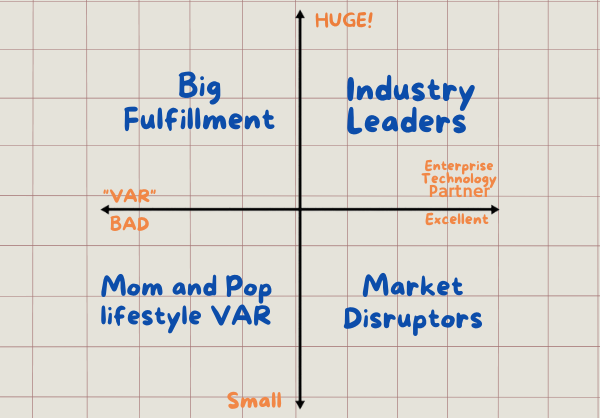All pieces of hardware and technology have an expected life cycle. They have a finite amount of time they function properly, after which they need to be replaced. And all of them come with a reasonable prediction as to how long they’ll last in their expected work environment.
Sometimes a company has hardware that lasts long past its expected life cycle. Any breakdowns are repairable, and they find a way to integrate it into new work processes, so they keep using it. If it still works, the business can save money every year and keep it going, right?
Unfortunately, that philosophy is very wrong. The “good luck” that keeps a piece of technology in operation longer than expected is bad for business. Every year a company uses that hardware past its expected life cycle will cost money in terms of reliability and productivity. Utilizing the hardware for too long carries additional risks that far outweigh the costs associated with updating it, and many companies are utilizing a technology refresh cycle to avoid falling into this common financial trap.
What is a Technology Refresh Cycle?
A technology refresh sets a regular schedule for replacing and updating hardware on a department-wide (or company-wide) basis. Instead of hanging on to every piece of technology until it breaks down completely, the refresh allows the company to plan on regular replacements whether the old tech is still working or not.
The “downside” (and what keeps some managers from implementing a technology refresh) is that you’re replacing hardware that still works. From a short-term standpoint, replacing it looks like an avoidable expense that could be put off for another year or two. However a long-term approach reveals the practical and financial benefits of getting your business on a technology refresh cycle.
Four Advantages of the Technology Refresh Cycle
- Staying Current. By sticking to a refresh cycle, there’s no concern that the older hardware might not work well with the newer purchases. Industry standards and specifications change frequently, and technology is always advancing. Your network and workflow efficiency will be determined by the “weak link” in the chain, and that link will usually be your aging hardware. Instead of spending valuable time making older tools communicate properly or fit into a growing operations system, all the technology will be at a similar point in their life cycle and expected to function smoothly within the organization.
Keeping hardware current can also improve employee satisfaction; since they have the tools necessary to do their jobs faster and easier and reduce frustrations associated with trying to get old technology to work properly.
- Increased Security. If security is important to a business (and what business exists where it isn’t important?) then a technology refresh cycle helps protect the company and its clients from threats. Bad actors see aging infrastructure as a collection of vulnerabilities and opportunities since some items are unable to utilize the latest virus and cyber-attack defenses. Malicious tools that won’t work on newer technology might be successful on a piece of hardware that’s well past its expected life cycle. The damage from one attack could wipe out any perceived savings, lose credibility with clients, cause compliance headaches, and create expensive repairs to your network. And at that point, you’d have to replace the old hardware anyway, and you’d be in a rush to do it. But with a technology refresh cycle, all hardware can adopt the latest protections and the entire network will enjoy reduced vulnerabilities.
- Reduced Downtime. If you’re stretching the life of an old piece of technology and keeping it until it breaks down, you’re only delaying the inevitable. Eventually, it willbreak down. And when it does, you’re guaranteeing all related departments some downtime. In the best-case scenario, certain functions will be limited or unavailable. But if it’s an important piece of hardware, the entire network could be affected, clients might be impacted and business might be delayed. All managers understand the time and money costs associated with addressing downtime once it occurs.
While the risk of downtime can never be eliminated, a technology refresh cycle allows you to reduce its likelihood and possibly avoid hardware-related downtime altogether. By the time the technology enters the phase where it’s likely to falter, it will already be replaced. Avoiding downtime increases efficiency and adds a level of reliability that won’t be accomplished by hoping older hardware keeps beating the odds.
- Budget Predictability. A technology refresh cycle allows companies to plan their hardware purchases well in advance and adds stability to long-term budgets. Instead of wondering if this is the year a major expenditure will occur, or dealing with various technology purchases over a few years (at which time the cycle starts again), the refresh cycle adds a level of predictability that can be planned and budgeted well in advance.
That predictability also makes the purchasing process easier. Since the process begins before the hardware breaks down or needs to be replaced, the business can take time to make sure the purchases are the right ones for their situation and offer the most value relative to other options. The worst time to make a purchase is when the business depends on the transaction being completed immediately. The technology refresh cycle is known well in advance and eliminates the time pressures of making decisions when something needs to be replaced at once. By improving budgeting and purchasing decisions, the cycle allows management to make more informed choices and the business runs more smoothly.
More Questions?
If you need to know more about how a technology refresh cycle can help your business, Imperium Data is here to help. We have the knowledge and experience to detail the specific benefits that apply to your unique situation, and we can help you plan and create a refresh cycle that maximizes those benefits. Simply use our contact page to begin the conversation.



